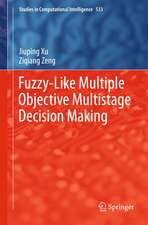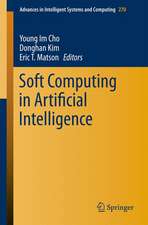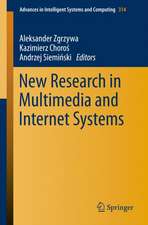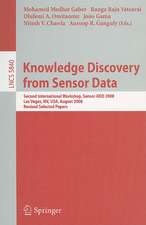Astronomy and Big Data: A Data Clustering Approach to Identifying Uncertain Galaxy Morphology: Studies in Big Data, cartea 6
Autor Kieran Jay Edwards, Mohamed Medhat Gaberen Limba Engleză Hardback – 29 apr 2014
This book reports on how to use data mining, more specifically clustering, to identify galaxies that the public has shown some degree of uncertainty for as to whether they belong to one morphology type or another. The book shows the importance of transitions between different data mining techniques in an insightful workflow. It demonstrates that Clustering enables to identify discriminating features in the analysed data sets, adopting a novel feature selection algorithms called Incremental Feature Selection (IFS). The book shows the use of state-of-the-art classification techniques, Random Forests and Support Vector Machines to validate the acquired results. It is concluded that a vast majority of these galaxies are, in fact, of spiral morphology with a small subset potentially consisting of stars, elliptical galaxies or galaxies of other morphological variants.
| Toate formatele și edițiile | Preț | Express |
|---|---|---|
| Paperback (1) | 636.73 lei 6-8 săpt. | |
| Springer International Publishing – 3 sep 2016 | 636.73 lei 6-8 săpt. | |
| Hardback (1) | 641.01 lei 6-8 săpt. | |
| Springer International Publishing – 29 apr 2014 | 641.01 lei 6-8 săpt. |
Din seria Studies in Big Data
- 20%
 Preț: 861.39 lei
Preț: 861.39 lei - 20%
 Preț: 997.77 lei
Preț: 997.77 lei - 20%
 Preț: 586.44 lei
Preț: 586.44 lei - 18%
 Preț: 993.91 lei
Preț: 993.91 lei - 20%
 Preț: 1165.69 lei
Preț: 1165.69 lei - 20%
 Preț: 980.88 lei
Preț: 980.88 lei - 20%
 Preț: 1440.41 lei
Preț: 1440.41 lei - 20%
 Preț: 1159.89 lei
Preț: 1159.89 lei - 20%
 Preț: 1470.90 lei
Preț: 1470.90 lei - 20%
 Preț: 1178.88 lei
Preț: 1178.88 lei - 20%
 Preț: 1170.62 lei
Preț: 1170.62 lei - 20%
 Preț: 1158.26 lei
Preț: 1158.26 lei - 20%
 Preț: 999.02 lei
Preț: 999.02 lei - 20%
 Preț: 926.47 lei
Preț: 926.47 lei - 18%
 Preț: 1009.40 lei
Preț: 1009.40 lei - 20%
 Preț: 988.32 lei
Preț: 988.32 lei - 15%
 Preț: 636.80 lei
Preț: 636.80 lei - 20%
 Preț: 650.92 lei
Preț: 650.92 lei - 20%
 Preț: 655.85 lei
Preț: 655.85 lei - 20%
 Preț: 924.33 lei
Preț: 924.33 lei - 20%
 Preț: 1041.76 lei
Preț: 1041.76 lei - 20%
 Preț: 1439.10 lei
Preț: 1439.10 lei - 18%
 Preț: 722.89 lei
Preț: 722.89 lei - 20%
 Preț: 1048.78 lei
Preț: 1048.78 lei - 20%
 Preț: 1160.55 lei
Preț: 1160.55 lei - 20%
 Preț: 921.85 lei
Preț: 921.85 lei - 20%
 Preț: 1624.52 lei
Preț: 1624.52 lei - 20%
 Preț: 333.88 lei
Preț: 333.88 lei - 20%
 Preț: 1039.79 lei
Preț: 1039.79 lei - 20%
 Preț: 989.79 lei
Preț: 989.79 lei - 20%
 Preț: 1017.47 lei
Preț: 1017.47 lei - 20%
 Preț: 987.82 lei
Preț: 987.82 lei - 20%
 Preț: 650.27 lei
Preț: 650.27 lei
Preț: 641.01 lei
Preț vechi: 801.27 lei
-20% Nou
Puncte Express: 962
Preț estimativ în valută:
122.70€ • 133.32$ • 103.13£
122.70€ • 133.32$ • 103.13£
Carte tipărită la comandă
Livrare economică 21 aprilie-05 mai
Preluare comenzi: 021 569.72.76
Specificații
ISBN-13: 9783319065984
ISBN-10: 331906598X
Pagini: 100
Ilustrații: XII, 105 p. 54 illus., 24 illus. in color.
Dimensiuni: 155 x 235 x 15 mm
Greutate: 0.3 kg
Ediția:2014
Editura: Springer International Publishing
Colecția Springer
Seria Studies in Big Data
Locul publicării:Cham, Switzerland
ISBN-10: 331906598X
Pagini: 100
Ilustrații: XII, 105 p. 54 illus., 24 illus. in color.
Dimensiuni: 155 x 235 x 15 mm
Greutate: 0.3 kg
Ediția:2014
Editura: Springer International Publishing
Colecția Springer
Seria Studies in Big Data
Locul publicării:Cham, Switzerland
Public țintă
ResearchCuprins
Introduction.- Astronomy, Galaxies and Stars: An Overview.- Astronomical Data Mining.- Adopted Data Mining Methods.- Research Methodology.- Development of Data Mining Models.- Experimentation Results.- Conclusion and Future Work.
Textul de pe ultima copertă
With the onset of massive cosmological data collection through media such as the Sloan Digital Sky Survey (SDSS), galaxy classification has been accomplished for the most part with the help of citizen science communities like Galaxy Zoo. Seeking the wisdom of the crowd for such Big Data processing has proved extremely beneficial. However, an analysis of one of the Galaxy Zoo morphological classification data sets has shown that a significant majority of all classified galaxies are labelled as “Uncertain”.
This book reports on how to use data mining, more specifically clustering, to identify galaxies that the public has shown some degree of uncertainty for as to whether they belong to one morphology type or another. The book shows the importance of transitions between different data mining techniques in an insightful workflow. It demonstrates that Clustering enables to identify discriminating features in the analysed data sets, adopting a novel feature selection algorithms called Incremental Feature Selection (IFS). The book shows the use of state-of-the-art classification techniques, Random Forests and Support Vector Machines to validate the acquired results. It is concluded that a vast majority of these galaxies are, in fact, of spiral morphology with a small subset potentially consisting of stars, elliptical galaxies or galaxies of other morphological variants.
This book reports on how to use data mining, more specifically clustering, to identify galaxies that the public has shown some degree of uncertainty for as to whether they belong to one morphology type or another. The book shows the importance of transitions between different data mining techniques in an insightful workflow. It demonstrates that Clustering enables to identify discriminating features in the analysed data sets, adopting a novel feature selection algorithms called Incremental Feature Selection (IFS). The book shows the use of state-of-the-art classification techniques, Random Forests and Support Vector Machines to validate the acquired results. It is concluded that a vast majority of these galaxies are, in fact, of spiral morphology with a small subset potentially consisting of stars, elliptical galaxies or galaxies of other morphological variants.
Caracteristici
Presents recent applications of Big Data research to Astronomy Demonstrates the application of Big data to the Galaxy Zoo project, where a large collection of galaxy images are annotated by citizen scientists Presents a Data Clustering Approach to Identifying Uncertain Galaxy Morphology























